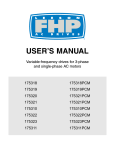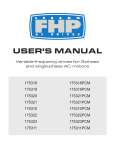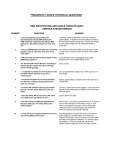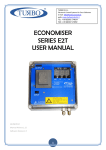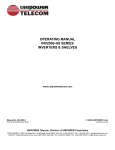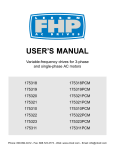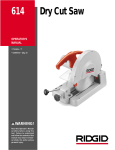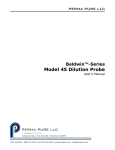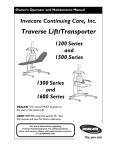Download RIDGID Dry Cut Saw Operator`s manual
Transcript
614 OPERATOR’S MANUAL • Français – 11 • Castellano – pág. 23 WARNING! Read this Operator’s Manual carefully before using this tool. Failure to understand and follow the contents of this manual may result in electrical shock, fire and/or serious personal injury. Dry Cut Saw 614 Dry Cut Saw Table of Contents Recording Form for Machine Serial Number ..............................................................................................................1 General Safety Information Work Area Safety........................................................................................................................................................2 Electrical Safety ..........................................................................................................................................................2 Personal Safety...........................................................................................................................................................2 Tool Use and Care......................................................................................................................................................3 Service ........................................................................................................................................................................3 Specific Safety Information Dry Cutter Safety ........................................................................................................................................................3 Description, Specifications and Standard Equipment Description ..................................................................................................................................................................4 Specifications..............................................................................................................................................................4 Standard Equipment ...................................................................................................................................................4 Inspect Dry Cut Saw......................................................................................................................................................4 Saw and Work Area Set-Up ..........................................................................................................................................5 Operating Dry Cut Saw Clamping The Workpiece............................................................................................................................................5 Cutting With Dry Cut Saw ...........................................................................................................................................6 Removing The Workpiece...........................................................................................................................................7 Tips For Using Dry Cut Saw .........................................................................................................................................7 Maintenance Instructions Changing Saw Blade ..................................................................................................................................................7 Replacing Brushes......................................................................................................................................................8 Saw Storage ...............................................................................................................................................................8 Service and Repair ........................................................................................................................................................9 Wiring Diagram............................................................................................................................................................10 Lifetime Warranty ........................................................................................................................................Back Cover ii Ridge Tool Company 614 Dry Cut Saw 614 Dry Cut Saw Record Serial Number below and retain product serial number which is located on nameplate. Serial No. 614 Dry Cut Saw General Safety Information WARNING! Read and understand all instructions. Failure to follow all instructions listed below may result in electric shock, fire, and/or serious personal injury. SAVE THESE INSTRUCTIONS! Work Area Safety • Keep your work area clean and well lit. Cluttered benches and dark areas invite accidents. • Do not operate tools in explosive atmospheres, such as in the presence of flammable liquids, gases, or dust. Tools create sparks which may ignite the dust or fumes. • Keep bystanders, children, and visitors away while operating a tool. Distractions can cause you to lose control. • Keep floors dry and free of slippery materials such as oil. Slippery floors invite accidents. Electrical Safety Cover of grounded outlet box • Use proper extension cords. (See chart.) Insufficient conductor size will cause excessive voltage drop and loss of power. Minimum Wire Gauge for Extension Cord Nameplate Total Length (in feet) Amps 0 – 25 26 – 50 51 – 100 0–6 18 AWG 16 AWG 16 AWG 6 – 10 18 AWG 16 AWG 14 AWG 10 – 12 16 AWG 16 AWG 14 AWG 12 – 16 14 AWG 12 AWG NOT RECOMMENDED • Stay alert, watch what you are doing and use common sense when operating a power tool. Do not use tool while tired or under the influence of drugs, alcohol, or medications. A moment of inattention while operating power tools may result in serious personal injury. • Dress properly. Do not wear loose clothing or jewelry. Contain long hair. Keep your hair, clothing, and gloves away from moving parts. Loose clothes, jewelry, or long hair can be caught in moving parts. • Avoid accidental starting. Be sure switch is OFF before plugging in. Plugging in tools that have the switch ON invites accidents. • Remove adjusting keys before turning the tool ON. A wrench or a key that is left attached to a rotating part of the tool may result in personal injury. Grounding prong • Avoid body contact with grounded surfaces. There is an increased risk of electrical shock if your body is grounded. • Do not overreach. Keep proper footing and balance at all times. Proper footing and balance enables better control of the tool in unexpected situations. • Do not expose electrical tools to rain or wet conditions. Water entering a tool will increase the risk of electrical shock. • Use safety equipment. Always wear eye protection. Dust mask, non-skid safety shoes, hard hat, or hearing protection must be used for appropriate conditions. • Do not abuse cord. Never use the cord to pull the plug from an outlet. Keep cord away from heat, oil, sharp edges or moving parts. Replace damaged cords immediately. Damaged cords increase the risk of electrical shock. 2 • Use only three-wire extension cords which have three-prong grounding plugs and three-pole receptacles which accept the machines plug. Use of other extension cords will not ground the tool and increase the risk of electrical shock. Personal Safety • Grounded tools must be plugged into an outlet properly installed and grounded in accordance with all codes and ordinances. Never remove the grounding prong or modify the plug in any way. Do not use any adapter plugs. Check with a qualified electrician if you are in doubt as to whether the outlet is properly grounded. If the tools should electrically malfunction or break down, grounding provides a low resistance path to carry electricity away from the user. Grounding prong • When operating a power tool outside, use an outdoor extension cord marked “W-A” or “W”. These cords are rated for outdoor use and reduce the risk of electrical shock. WARNING Some dust created by power sanding, sawing, grinding, drilling and other construction activities contains chemicals known to the State of California to Ridge Tool Company 614 Dry Cut Saw cause cancer, birth defects or other reproductive harm. Some examples of these chemicals are: • lead from lead-based paints • crystalline silica from bricks and cement and other masonry products • arsenic and chromium from chemically-treated lumber Your risk from these exposures varies, depending on how often you do this type of work. To reduce your exposure to these chemicals: work in a well ventilated area and work with approved safety equipment such as those dust masks that are specially designed to filter out microscopic particles. Service • Tool service must be performed only by qualified repair personnel. Service or maintenance performed by unqualified repair personnel could result in injury. • When servicing a tool, use only identical replacement parts. Follow instructions in the Maintenance Section of this manual. Use of unauthorized parts or failure to follow maintenance instructions may create a risk of electrical shock or injury. Specific Safety Information Tool Use and Care WARNING • Use clamps or other practical way to secure and support the workpiece to a stable platform. Holding the workpiece by hand or against your body is unstable and may lead to loss of control. Read this operator’s manual carefully before using the 614 Dry Cut Saw. Failure to understand and follow the contents of this manual may result in electrical shock, fire and/or serious personal injury. • Do not force tool. Use the correct tool for your application. The correct tool will do the job better and safer at the rate for which it is designed. Call the Ridge Tool Company, Technical Service Department at (800) 519-3456 if you have any questions. • Do not use tool if switch does not turn it ON or OFF. Any tool that cannot be controlled with the switch is dangerous and must be repaired. • Disconnect the plug from the power source before making any adjustments, changing accessories, or storing the tool. Such preventive safety measures reduce the risk of starting the tool accidentally. • Store idle tools out of the reach of children and other untrained persons. Tools are dangerous in the hands of untrained users. • Maintain tools with care. Keep cutting tools sharp and clean. Properly maintained tools with sharp cutting edges are less likely to bind and are easier to control. • Check for misalignment or binding of moving parts, breakage of parts, and any other condition that may affect the tool's operation. If damaged, have the tool serviced before using. Many accidents are caused by poorly maintained tools. • Use only accessories that are recommended by the manufacturer for your model. Accessories that may be suitable for one tool may become hazardous when used on another tool. • Inspect tool and extension cords periodically and replace if damaged. Damaged cords increase the risk of electrical shock. • Keep handles dry and clean; free from oil and grease. Allows for better control of the tool. Dry Cut Saw Safety • Wear safety glasses and ear protection. Protects eyes from foreign objects. Prevents loss of hearing. • Keep all guards in place and in working order. Never clamp or tie guard in the open position. Exposed blade increases the risk of injury. • Set up the dry cutting saw on a flat, level surface. Be sure the saw is stable. Will prevent tipping of the unit. • Always clamp the workpiece with vise. Do not perform any operation freehand. Prevents loss of control of the workpiece. • Do not place either hand in the working area when tool is connected to power source. Never reach around or in back of the saw blade. Increases the risk of injury. • Allow motor to reach full speed before cutting. Prevents stalling of motor. • Use only cut-off saw blade with speed rating at least as high as the RPM specified on the nameplate. Improper blade may be hazardous and result in injury. • Workpiece must be cut off against the direction of the saw only. Prevents workpiece from being thrown. • Be sure cut-off saw is sharp and free from vibration. Less likely to bind and lose control. Ridge Tool Company 3 614 Dry Cut Saw • Raise the cut-off saw from the kerf of the workpiece prior to releasing the trigger switch. Less likely for saw blade to bind. Description, Specifications and Standard Equipment Description The RIDGID 614 Dry Cut Saw is designed to cut ferrous and non-ferrous pipe and irregular materials such as the following: • Gas pipe, lining tube, electrical pipe and conduit and PVC pipe. • Steel angle, channel and bar • Aluminum frame, curtain rail and a variety of interior decoration material A two-lever vise clamps the workpiece and allows an angle cut from 45º to 90º. The motor operates on a 115 volt, single phase, 50-60 Hertz, AC current. Specifications Cutting Capacity: Model 614 Capacity Chart Cutting Angle WARNING To prevent serious injury, inspect your Dry Cut Saw on a regular basis. The following inspection procedures should be performed before each use of the tool: 1. Inspect the power cord and plug for damage. If the grounding prong is missing or the cord is damaged, do not use the tool until the cord has been replaced. 2. Make sure the switches turn the tool ON and OFF. If broken, do not use until they are replaced. NOTE! Switch Action (Figure 4) There is a LOCK-OFF switch button on the handle. To start the tool, first depress the LOCK-OFF switch button and then pull the trigger. The trigger will not work before the LOCK-OFF switch button is depressed. 3. Inspect the saw for any broken, missing, misaligned or binding parts as well as any conditions which may affect the safe and normal operation of the tool. If any of these conditions are present, do not use the tool until the problem has been repaired. Do not use dull or damaged blades. Workpiece Geometry 4. Make sure all guards are in place and in working order. 5. Clean any oil, grease or dirt from the handles. This reduces the risk of injury due to the tool slipping from your grip. 90˚ Cuts 5″ 130mm 33/4″ x 7″ 95mm x 180mm 41/2″ x 41/2″ 115mm x 115mm 45˚ Cuts 4″ 100mm 31/2″ x 4″ 90mm x 100mm 31/2″ x 31/2″ 90mm x 90mm CAUTION Inspect Dry Cut Saw 6. Use only accessories recommended for your tool. Accessories used for other tools may be hazardous when used on this saw and lead to serious injury. Cutting of larger shapes not recommended. Motor: Type ............................Universal Volts ............................115AC, 50-60Hz Amps...........................15 Amps No Load Speed ...........1300 RPM Blade Size .....................14″ x .087″ x 1″ Weight ...........................49 lbs. 7. Inspect the cutting edges of your saw blade. If necessary, replace prior to using. Dull or damaged cutting edges can lead to injury, tool breakage or excessive heat build-up in the workpiece and the tool. Check that the speed rating of the saw blade is at least 1300 RPM. 8. Clean metal shavings and other debris from the chip tray located at the rear of the saw (Figure 1). Standard Equipment • Dry Cut Saw • 14″ Blade (Installed) • Two (2) Allen Wrenches 4 Ridge Tool Company 614 Dry Cut Saw earlier. If the power cord does not reach the outlet, use an extension cord in good condition. WARNING To avoid electrical shock and electrical fires, never use an extension cord that is damaged or does not meet the following requirements: • The cord has a three-prong plug similar to shown in Electrical Safety section. • The cord is rated as “W” or “W-A” if being used outdoors. Figure 1 – Cleaning Metal Shavings From Chip Tray Saw and Work Area Set-Up • The cord has sufficient wire thickness (14 AWG below 25′/12 AWG 25′ - 50′). If the wire thickness is too small, the cord may overheat, melting the cord’s insulation or causing nearby objects to ignite. WARNING To reduce risk of electrical shock, keep all electrical connections dry and off the ground. Do not touch plug with wet hands. Make sure power cord is clear of saw blade. NOTE! Use of extension cords over 50 ft is not recommended. An improper extension cord will result in deterioration of the performance of the saw. WARNING 5. Check the unit to insure it is operating properly. • To start the tool, firmly grasp the handle then depress LOCK-OFF switch button. Keeping the LOCK-OFF switch button depressed, pull the trigger switch (Figure 4). To prevent serious injury, proper set-up of the saw and work area is required. The following procedures should be followed to set-up the dry cut saw: • Depress and hold the switch. Inspect the moving parts for misalignment, binding, odd noises or any other unusual conditions that may affect the safe and normal operation of the saw. Make sure saw is free from vibration. If such conditions are present, have the saw serviced. 1. Locate a work area that has the following: • Adequate lighting • No flammable liquids, vapors or dust that may ignite. • Release the trigger switch. • Grounded 15 amp electrical outlet • Clear path to the electrical outlet that does not contain any sources of heat or oil, sharp edges or moving parts that may damage electrical cord. Operating Dry Cut Saw WARNING • Dry place for saw and operator. Do not use the saw while standing in water. • Level ground 2. Clean up the work area prior to setting up any equipment. To prevent slips and falls, always wipe up any oil that may be present. 3. Place the dry cut saw on a stable, level surface. If workpiece extends more than four (4′) feet beyond the saw, use one or more pipe supports. WARNING Failure to properly support the workpiece can result in the unit tipping or the workpiece falling. Wear safety glasses and ear protection. Make sure guards are in place and in working order. Always clamp the workpiece with the vise. Do not perform any operation freehand. Keeps hands out of the path of saw blade. Never reach around or in back of the saw blade. 4. Plug the saw into the electrical outlet making sure to position the power cord along the clear path selected Ridge Tool Company 5 614 Dry Cut Saw Clamping the Workpiece 1. Dry Cut Saw is equipped with a two-lever vise that can be adjusted to make an angle cut from 45º to 90º, right and left. To adjust the vise, loosen the two bolts of the fence guard and move to the desired angle (Figure 2). Retighten the bolts the lock the fence guide in place. NOTE! Always use both hands when using the vise to prevent saw from tipping. NOTE! For smoother operation and extended life, keep the vise mechanism lubricated. Cutting with Dry Cut Saw 1. To start the tool, firmly grasp the handle, then depress LOCK-OFF switch button (Figure 4). Keeping the LOCK-OFF switch button depressed, pull the trigger switch. Be sure to allow the motor to reach maximum speed prior to cutting (Figure 5). Lock Off Switch Trigger Figure 2 – Fence Adjustment For Angle Cut 2. Raise the upper lever to release the feed mechanism (Figure 3). Place the workpiece into the vise. If it extends more than four (4) feet beyond the saw, use one or more pipe stands to support the workpiece. WARNING Failure to properly support the workpiece can result in the tipping of the unit or binding of the saw blade. Figure 4 – Switch Controls WARNING Keep hands out of the path of the saw blade. Never reach around or in back of the saw blade. 2. Hold the workpiece firmly. Cut the workpiece slowly and evenly. Raise the handle from the workpiece and release the trigger switch to turn saw OFF. Leave the handle only when the tip saw blade is completely stopped. Horizontal Lever CAUTION Raise the cut off saw from the kerf of the workpiece prior to releasing the trigger switch. Less likely for the saw blade to bind. Upper Lever Figure 3 – Two-Lever Vise Controls 3. Push the horizontal lever until the vise contacts the workpiece (Figure 3). 4. Bring the upper lever to the horizontal position to secure the workpiece in the vise. Figure 5 – Cutting Workpiece 6 Ridge Tool Company 614 Dry Cut Saw Removing the Workpiece 1. Raise the upper lever of the vise to release the workpiece. Pull back on the horizontal lever to allow the workpiece to be easily removed from the vise. Pivot Pin 2. Slide the workpiece out of the saw keeping a firm grip on the workpiece as it clears the saw. WARNING To avoid injury from falling parts or equipment tip-overs when handling long workpieces, make sure that the end farthest from the saw is supported prior to removal. Tips For Using The Dry Cut Saw Life of the dry cut saw blade will depend on proper use of the saw. Procedures that should be followed are as follows: • Do not force the blade into the material to be cut. • Only cut material within the specified capacity for the saw blade. • Let the machine reach full speed before starting to cut. • NEVER stop and restart with the blade in contact with the material. This will break the teeth. • Clamp the material correctly and ensure that is it centered relative to the blade (Figure 6). Figure 6 – Clamping The Workpiece Figure 7 – Removing Cover 3. Press the spindle lock (Figure 8). Place the hex wrench on the arbor bolt, unscrew the bolt and remove the blade carefully. 4. Slide the new blade onto the arbor shaft making certain that the blade marking indicates rotation in a counter-clockwise direction. Also make sure the blade rotates the same direction as the arrow shown on the safety cover (Figure 9). Then, put back the outer flange washer and arbor bolt. WARNING Maintenance Instructions Make sure the blade hex bolt is securely tightened. WARNING Always be sure that the tool is switched OFF and unplugged before changing blade or servicing saw. Changing Saw Blade 1. Remove the power cord plug from the receptacle, then place the plug in a location where someone will not plug it in by mistake. 2. Loosen the three (3) screws on the safety cover then rotate it clockwise around pivot pin to expose the arbor shaft (Figure 7). Ridge Tool Company 7 614 Dry Cut Saw Spindle Lock Figure 10 – Carbon Brush Wear 2. Use the slotted ( – ) screw driver to remove the brush caps (Figure 11). Figure 8 – Removing Saw Blade Figure 11 – Removing Brush Caps 3. Take out the worn brushes inside, put in new ones and replace the caps. Saw Storage Figure 9 – Installing Saw Blade 5. Rotate safety cover back to its position and replace the three (3) screws. WARNING WARNING Motor-driven equipment must be kept indoors or well covered in rainy weather. Store the machine in a locked area that is out of reach of children and people unfamiliar with saws. This saw can cause serious injury in the hands of untrained users. Never use this saw with the guard re- moved. Replacing Carbon Brushes 1. Replace carbon brushes when they wear down to about 1/4″ (6mm) or sparking will occur. Both brushes should be changed at the same time (Figure 10). 8 Ridge Tool Company 614 Dry Cut Saw Service and Repair WARNING The “Maintenance Instructions” will take care of most of the service needs of this saw. Any problems not addressed by this section should only be handled by an authorized RIDGID service technician. Tool should be taken to a RIDGID Independent Authorized Service Center or returned to the factory. All repairs made by Ridge service facilities are warranted against defects in material and workmanship. WARNING When servicing this saw, only identical replacement parts should be used. Failure to follow these instructions may create a risk of electrical shock or other serious injury. If you have any questions regarding the service or repair of this machine, call or write to: Ridge Tool Company Technical Service Department 400 Clark Street Elyria, Ohio 44035-6001 Tel: (800) 519-3456 E-Mail: [email protected] For name and address of your nearest Independent Authorized Service Center, contact the Ridge Tool Company at (800) 519-3456 or http://www.ridgid.com Ridge Tool Company 9 614 Dry Cut Saw Wiring Diagram RED YELLOW NEUTRAL ON/OFF SWITCH WHITE BLACK GROUND BLUE GREEN BLACK GREEN 10 Ridge Tool Company












